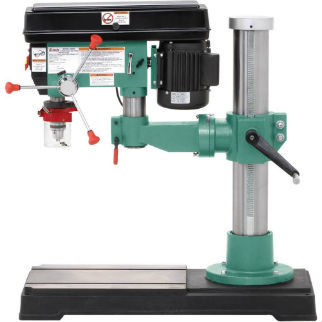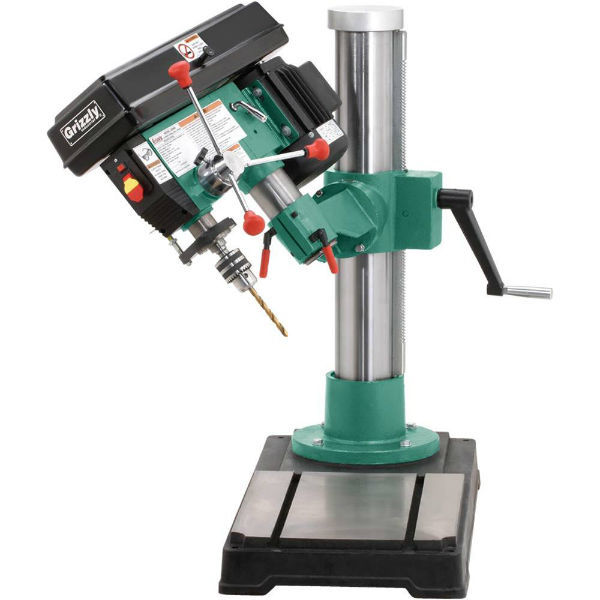Radial drill presses are a little different than a standard drill press and you may be wondering what they are and how they work...
Am I Right?
These are a little bit more versatile than a standard drill press but there are also trade-offs that you should be aware of too...

In this article, we are going to look at some of the advantages and some of the things you have to watch out for if you are considering a radial drill press. This will also be a helpful article for those of you out there that are considering a radial version vs a standard press.
What Is A Radial Drill Press?
A radial drill press is able to pivot from it's head, usually in both directions, instead of the table pivoting. Some models also have a sliding feature that allows the headstock to slide, (front to back) like a sliding miter saw would. This is sometimes referred to as a "variable swing".
The table is still able to pivot (in most models) but the head is also able to pivot, making it much more versatile, especially for larger work pieces. There is a great video that shows one of these in action and will give you a good feel for the tool.
Where Can I Find One Of These?
These are a little bit harder to find but I did find a few online at Amazon, Ebay and Sears. Other places were manufacturers and some allowed online ordering but others did not and gave a list of distributors instead.
What Are Radial Drill Presses Used For?
This is a fairly simple question that has a fairly simple answer and because of the radial drill presses two main distinguishing factors (sliding and tilting head) they are really made for larger workpieces, that's the short answer, anyways.
Larger workpieces will usually require a very large drill press to "fill the order", especially if you want to drill at an angle. Just imagine trying to tilt a very large workpiece on a drill press table and you can just imagine some of the problems you might encounter. This is where a radial drill press really shines and "fills that gap".
The Different Types Of Radial Drill Presses:
There are two main types of radial drill presses and they are a little bit different (feature-wise) that you should be aware of...
Radial Drill Press With Swiveling Headstock: This radial drill press is made by Grizzly and the headstock is able to swivel 360°, in conjunction with it being able to tilt 45° in either direction (left or right).
Everything else is pretty standard and what you would expect to see on a standard press.

Grizzly.com
Variable Swing Model: The "variable swing" models use a sliding mechanism, like you would find on a sliding miter saw and works the same way.
A knob usually controls the sliding action of the press and the headstock also tilts in either direction as well, the main feature of a radial drill press.

Grizzly.com
How To Use A Radial Drill Press...
Using a radial drill press really is not that much different than a standard drill press but there are a couple of things you have to look out for and be aware of, especially when using the tilting or sliding features...
Using The Slide Feature (Variable Swing)

- Set the workpiece on the table of the drill press and secure it to the table. It would help to have a reference line running along the entire piece, so you can line up the bit properly.
- Next, unlock the sliding mechanism and roll it out to the desired location (lowering the drill bit close to the work piece) until you are far enough out and lock the sliding mechanism in place.
- Double check the table, to ensure that you won't be hitting it with your drill bit once you pass through the material.
- Lower the bit to the work piece and make a hole, just like you would with a standard press.
Tilting The Headstock:

- The first step is to punch a guide mark into the material where you want to drill to prevent the drill bit from walking.
- Set the desired height of the table to the best possible position for drilling your work piece at the desired angle.
- Adjust the headstock to the proper angle and lock it into place.
- Double check the location of the bit to the guide mark and make sure it is properly aligned.
- Drill the hole using a slow and steady pressure until you are all the way through the material.
Benefits And Drawbacks Of A Radial Drill Press...
Radial drill presses seem like such a great tool, especially when compared to a standard drill press. Just like everything know, there are advantages and disadvantages to radio drill presses when compared to a standard drill press and these are things that people may not think about, or may just not be aware of.
Some Of The Benefits:
- One benefit using a radial drill press over a traditional one is that the swing is adjustable and slides back and forth (front to back) to accommodate larger work pieces.
- Another benefit of radial drill presses is the fact that the head can actually tilt both directions (usually) and can drill at an angle, similar to what would happen on a standard drill press if you were to angle the table itself.
Again, this would be ideal for larger work pieces that might hit the drill press had if you were to tilt the table at an angle.
A Few Of The Drawbacks:
- One of the major drawbacks to radial drill presses is also their strengths, primarily meaning all of those moving parts. Since a radial drill press slides back and forth and has the ability to tilt its head, they tend to be less precise than a standard drill press with fixed parts.
You could ensure that all moving parts are at their exact angles prior to drilling which would eliminate a lot of these issues but are extra steps that people usually don't like to take, this is a matter of personal preference, I guess. - Since the moving parts will more likely be used on a regular basis the majority of the time, it is a good practice to check for squareness every time you set the drill back to 0° (or 90°) and tighten all necessary parts (if you are able to).
- You will constantly have to make sure that the table is lined up with the bit properly so that the bit will not hit the table itself.
Like all drill press tables, there is a hole where the drill bit can penetrate through the table without damaging the table itself and since a radial drill press has the ability to slide front to back, the table also has that same ability, in order to line up the hole on the table to the bit in the chuck. - Balance can become somewhat of an issue (especially with benchtop radial drill presses) and you may have to secure the base of the press to the floor or table top (whatever the tool is sitting on) in order to make sure it is properly balanced when the tilt or slide feature is enabled on the tool.
- Since radial drill presses have the ability to slide front to back, you will need to make sure you have enough room in the back of the tool so it doesn't hit anything or reduce the capacity of the tool. You will also need to have a lot of room for one of these tools because of this.
Radial Drill Press Manufacturers:
There are a few different manufacturers that make radial drill presses and most of them are well-known names. Here is a quick list (with links) of some of the more popular manufacturers that make these tools:
Things To Watch Out For Regarding Radial Drill Presses...
- If you are planning on drilling at an angle, with the head of the tool tilted it is a good idea to have a small guide hole drilled first so that the bit won't track on the workpiece.
- Radial drill presses are a lot harder to find than a standard drill press and there are a lot less models to choose from as well so your options may be pretty limited if you're looking for a particular brand, a certain price range for one with specific capabilities.

